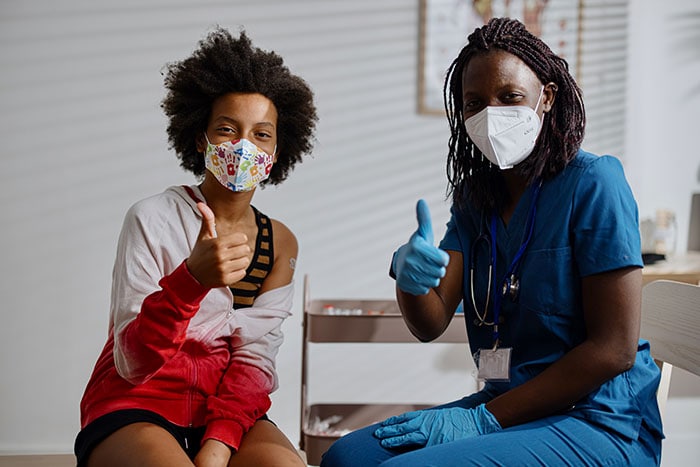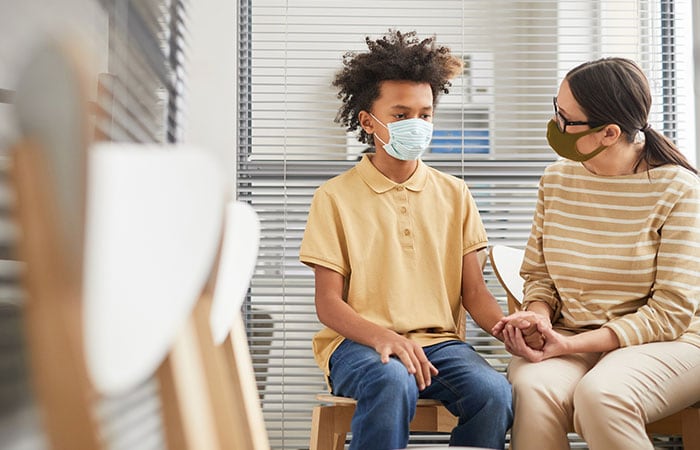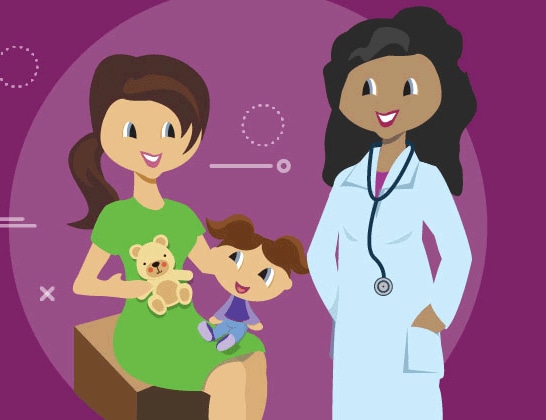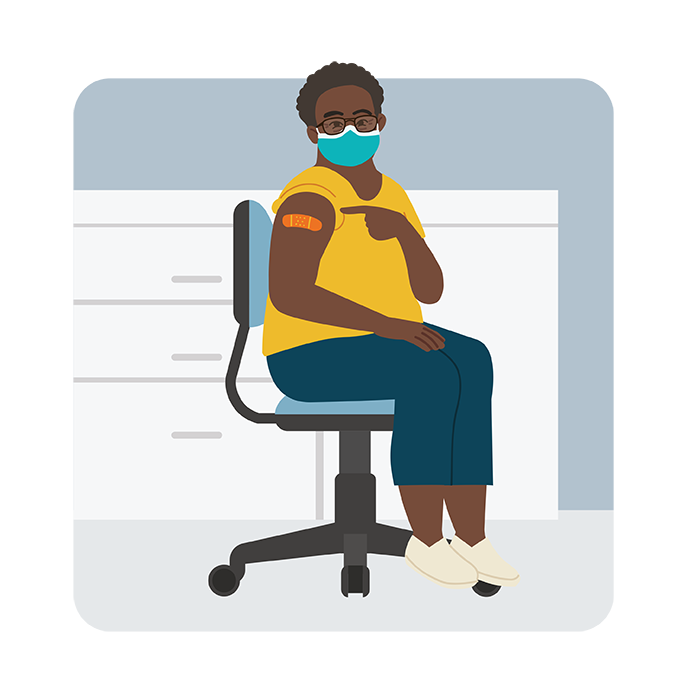Needle Fears and Phobia – Find Ways to Manage

You can learn to manage needle fears
Many people do not like needles as part of medical procedures when they receive care. But for some, the fear of needles is so great that it might prevent them from getting life-saving medical care, like vaccinations. This fear often affects children but can affect adults, too. Fear of needles is also common in people with certain conditions that cause difficulties with managing strong sensations, such as in people with mental, emotional, or behavioral disorders. Fear of needles can also be common in people with disabilities that make it hard for them to understand the procedures and communicate their concerns. There are ways to manage this fear. Learn what you can do so fear does not get in the way of important medical care including vaccines.
When Fears Become Phobia
Getting medications or vaccines through a needle – or having blood or other fluids taken by a needle – can be painful. Many people remember the discomfort and pain and worry about it occurring again when they return to get health procedures involving needles. This is typical. Younger children have fewer ways to handle their fears and need help and comfort from their parents or other caregivers. As children get older, many find ways to handle their fears on their own.
But for some, these fears are more severe, can persist into adolescence and adulthood, and are best described as phobias. Needle phobias can be learned from a past experience of pain, but there is also a biological component that makes some people react very strongly to the idea of procedures involving a needle.
Phobia means extreme fear that does not fit the danger or damage involved. Phobias are sometimes called ‘irrational’ because the feelings are real but much more extreme than the actual danger or harm.
These phobias can make procedures feel more painful, lead to severe panic, and in some cases to a physical response that causes fainting. This can make it extremely difficult to consider getting medical procedures involving needles. Estimates show that as many as 2 in 3 children and 1 in 4 adults have strong fears around needles. As many as 1 in 10 people might delay the COVID-19 vaccine due to these fears. People who have mental, emotional, or behavioral disorders such as anxiety disorders, people with certain disabilities, and people with certain conditions that affect how they manage sensations like touch or movement, may have more difficulty managing such fears. People with disabilities may be less likely to get vaccinations even though they may be more at risk for certain illnesses, such as severe effects of COVID-19. Parents who have fears of needles themselves may hesitate to have their children vaccinated.
Understanding Fears and Phobias
Showing fear is typical for younger children; but having extreme fear that lasts into adolescence and adulthood may lead to feelings of shame. People with phobias can include those who are highly tolerant of pain and risk, like those who play sports, manage injuries and illness without complaint, or even work in healthcare settings. The danger is imagined, but to the person, the fear or phobia is real and not a choice. It can feel like a part of the brain is playing tricks on the rest of the brain. Having a phobia does not mean using the fear to seek attention – people with a phobia might even hide the phobia and use other reasons to avoid getting the health care they need. Being around people who react negatively (by becoming angry or overly worried or fearful of the person’s fear) can make the fear worse. There are many positive ways parents, caregivers, and partners of people with a phobia can be supportive.
Managing Fears and Phobias
Fears and phobias can vary from mild to severe. For milder cases, preparation, support, and pain management can help.
- Information about the procedure: Understanding why the procedure involves needles and how it will protect the person can help.
- Understanding causes of fear:
- Pictures: Seeing pictures of needles and watching news about vaccination can cause feelings of fear. It may be useful to avoid these images unless they are used by a trained mental health provider as part of therapy.
- Words: For some people, substituting words like ‘shot’ with ‘poke’ might help limit the fear response.
- Surroundings: For fearful people, it may be best to be in a private space rather than a large room with other people who are also getting the procedure. Drive-through vaccination can help some people by allowing them to be in the comfort of their own car. Special clinics for people with disabilities may offer calm and quiet spaces.
- Understanding the procedure: Knowing where the procedure will take place, who will be around, and what will happen before, during, and after can help reduce fears.
- It is often best to be realistic – the provider or parent can explain that the vaccination might feel like a pinch or a poke, it may hurt, but usually just for a moment.
- Planning and practicing what will happen, including role playing or using books and videos that show the steps, may help fearful people prepare.
- Managing pain: Even though the pain from the needle is usually not severe, the brain still focuses on it; managing the pain can reduce fear and panic.
- Numbing creams and sprays: Healthcare providers can use medication that numbs the skin and prevents the person from feeling the procedure.
- Vibration or cooling: Small devices that create a buzzing feeling or cool the skin can help the brain focus on that sensation and block out the pain from the procedure.
- Distraction: Focusing on something else such as videos, toys, or even virtual reality devices can keep the person’s mind busy and away from the fear.
- Relaxation, breath control, and hypnosis: Learning how to do relaxing breaths and using hypnosis or self-hypnosis to calm the mind can help.
- Tailoring the strategies: Each person is different, and what works depends on the individual. Combining different strategies may be helpful. Healthcare providers can help develop a plan that works best for each person.
For extreme fears, it is best to talk to a mental health provider to understand how severe the problem is and plan the best strategies to treat the phobia. Treatment for phobias can include counseling, exposure therapy where the person gradually faces their fears with the support of a mental health provider in carefully planned steps, and/or medication.
What Parents, Caregivers, and Friends Can Do

Families and healthcare providers can help manage fears
People with fears and phobias need support as they work to manage their feelings during procedures involving needles. Having a trusted person who understands the fear, remains calm, and provides comfort during the procedure can help the fearful person. It is also helpful to let the fearful person know there is no shame in having fears, even when the danger is not real. Fear is not a choice, and it is not necessary to make the fear go away; the goal is to manage fear enough to get the important potentially life-saving procedure. Family and friends can become part of the plan that works best for a person and help encourage and support the person’s choices to cope and manage their fears.
What Healthcare Providers Can Do
Healthcare providers can increase their own awareness of needle fears and phobias. Providers can let their patients and family members know they understand that extreme fears and phobias are a real concern. Healthcare providers can offer information and support to decrease feelings of shame and fear and assist people with developing a plan to manage their fears. Different strategies for pain management can be offered as a routine part of procedures involving needles.

People who have fears may not talk about them with their providers and may hesitate getting medical care that involves a possibility of needles. Telehealth may provide a way to talk with patients about their fears and develop trust as the first step to getting the care that is needed.
Healthcare providers can work with families and caregivers to find ways to make getting vaccinations easier. For people with severe fears, a referral to a mental health provider may be appropriate.
Managing fears
- Before, During, and After Shots
- 9 Things to Make Shots Less Stressful for You and Your Child
- Healthcare Providers: Understanding Needle Fears and Phobia
- Easy to Read: Needle Phobia
- Stay safe from COVID-19: How I get my COVID-19 shot (Easy Read Social Story)
- Taking Fear and Pain Out of Needles—for Your Child and You | HealthyChildren.org
- Anxiety Disorder Treatment | NIMH
- Panic Disorder | NIMH
- Coping with Fears and Worries: Wellbeing Tools for Children and Teens | NASEM
- Helpful Tips for Getting the COVID-19 Vaccine, Even If You’re Afraid of Needles | Oregon.gov
Information about COVID-19 and vaccines
References
- Abado E, Aue T, Okon-Singer H. Cognitive biases in blood-injection-injury phobia: A review. Review. Frontiers in Psychiatry. 2021-July-13 2021;12(1158)doi:10.3389/fpsyt.2021.678891
- Blount RL, Piira T, Cohen LL, Cheng PS. Pediatric procedural pain. Behavior Modification. 2006;30(1):24-49. doi:10.1177/0145445505282438
- Freeman D, Lambe S, Yu LM, et al. Injection fears and COVID-19 vaccine hesitancy. Psychol Med. Jun 11 2021:1-11. doi:10.1017/s0033291721002609
- Huff C. How psychologists can help patients with injection fear: Psychologists are sharing interventions and therapies to help patients whose fear of needles could stop them from getting a COVID-19 vaccine APA Monitor. 2021;52(4). April 2, 2021. https://www.apa.org/monitor/2021/06/injection-fear
- Jarrett C, Wilson R, O’Leary M, Eckersberger E, Larson HJ. Strategies for addressing vaccine hesitancy – A systematic review. Vaccine. 2015;33(34):4180-4190. doi:https://doi.org/10.1016/j.vaccine.2015.04.040
- Jessup SC, Tomarken A, Viar-Paxton MA, Olatunji BO. Effects of repeated exposure to fearful and disgusting stimuli on fear renewal in blood-injection-injury phobia. Journal of Anxiety Disorders. 2020;74:102272. doi:https://doi.org/10.1016/j.janxdis.2020.102272
- Jiang MYW, Upton E, Newby JM. A randomised wait-list controlled pilot trial of one-session virtual reality exposure therapy for blood-injection-injury phobias. Journal of Affective Disorders. 2020;276:636-645. doi:https://doi.org/10.1016/j.jad.2020.07.076
- Lee VY, Caillaud C, Fong J, Edwards KM. Improving vaccine-related pain, distress or fear in healthy children and adolescents–a systematic search of patient-focused interventions. Human Vaccines & Immunotherapeutics. 2018;14(11):2737-2747. doi:10.1080/21645515.2018.1480238
- Lilliecreutz C, Josefsson A, Sydsjö G. An open trial with cognitive behavioral therapy for blood- and injection phobia in pregnant women—a group intervention program. Archives of Women’s Mental Health. 2010;13(3):259-265. doi:10.1007/s00737-009-0126-x
- Love AS, Love RJ. Considering needle phobia among adult patients during mass COVID-19 vaccinations. Journal of Primary Care & Community Health. Jan-Dec 2021;12. doi:10.1177/21501327211007393
- McLenon J, Rogers MAM. The fear of needles: A systematic review and meta-analysis. Journal of Advanced Nursing. Jan 2019;75(1):30-42. doi:10.1111/jan.13818
- McMurtry CM, Noel M, Taddio A, et al. Interventions for individuals with high levels of needle fear: Systematic review of randomized controlled trials and quasi-randomized controlled trials. The Clinical Journal of Pain. 2015;(31):S109-S123. doi:10.1097/AJP.0000000000000273
- Meindl JN, Saba S, Gray M, Stuebing L, Jarvis A. Reducing blood draw phobia in an adult with autism spectrum disorder using low-cost virtual reality exposure therapy. Journal of Applied Research in Intellectual Disabilities. 2019;32(6):1446-1452. doi:https://doi.org/10.1111/jar.12637
- Sokolowski CJ, Giovannitti JA, Jr., Boynes SG. Needle phobia: Etiology, adverse consequences, and patient management. Dental Clinics. 2010;54(4):731-744. doi:10.1016/j.cden.2010.06.012
- Sørensen K, Skirbekk H, Kvarstein G, Wøien H. Children’s fear of needle injections: a qualitative study of training sessions for children with rheumatic diseases before home administration. Pediatric Rheumatology. 2020;18(1):13. doi:10.1186/s12969-020-0406-6
- Taddio A, Ipp M, Thivakaran S, et al. Survey of the prevalence of immunization non-compliance due to needle fears in children and adults. Vaccine. 2012;30(32):4807-4812. doi:https://doi.org/10.1016/j.vaccine.2012.05.011
- Taddio A, McMurtry CM, Shah V, et al. Reducing pain during vaccine injections: clinical practice guideline. Canadian Medical Association Journal. 2015;187(13):975-982. doi:10.1503/cmaj.150391
- Tinker SC, Cogswell ME, Peacock G, Ryerson AB. Important considerations for COVID-19 vaccination of children with developmental disabilities. Pediatrics. 2021;148(4)doi:10.1542/peds.2021-053190
- Wani AL, Ara A, Bhat SA. Blood injury and injection phobia: the neglected one. Behavioral Neurology. 2014;2014:471340. doi:10.1155/2014/471340

